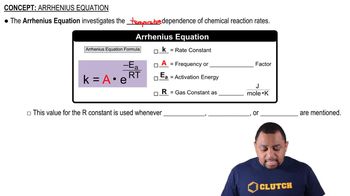Here are the essential concepts you must grasp in order to answer the question correctly.
Rate Laws and Reaction Order
Rate laws describe the relationship between the concentration of reactants and the rate of a chemical reaction. The order of a reaction indicates how the rate is affected by the concentration of reactants. In this case, the decomposition of nitric oxide (NO) is second order, meaning that the rate is proportional to the square of the concentration of NO. Understanding reaction order is crucial for applying the appropriate mathematical models to calculate reaction rates and activation energy.
Recommended video:
Arrhenius Equation
The Arrhenius equation relates the rate constant of a reaction to temperature and activation energy. It is expressed as k = A * e^(-Ea/RT), where k is the rate constant, A is the pre-exponential factor, Ea is the activation energy, R is the universal gas constant, and T is the temperature in Kelvin. This equation is fundamental for calculating activation energy from rate constants at different temperatures, as it shows how temperature influences reaction rates.
Recommended video:
Activation Energy
Activation energy (Ea) is the minimum energy required for a chemical reaction to occur. It represents the energy barrier that reactants must overcome to form products. A higher activation energy indicates that fewer molecules have sufficient energy to react at a given temperature, leading to a slower reaction rate. Calculating Ea is essential for understanding the temperature dependence of reaction rates and for designing strategies to control reactions, such as those involved in pollution control.
Recommended video:
 Verified step by step guidance
Verified step by step guidance

